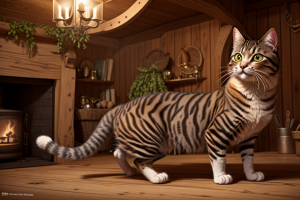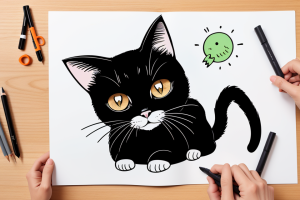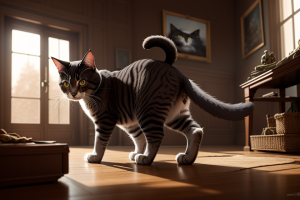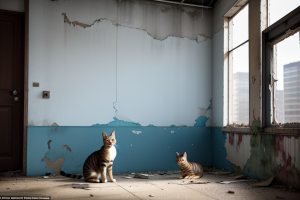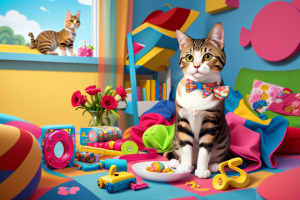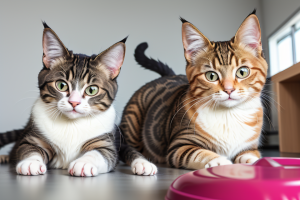What Role Do Cats Play in Artistic Representation?
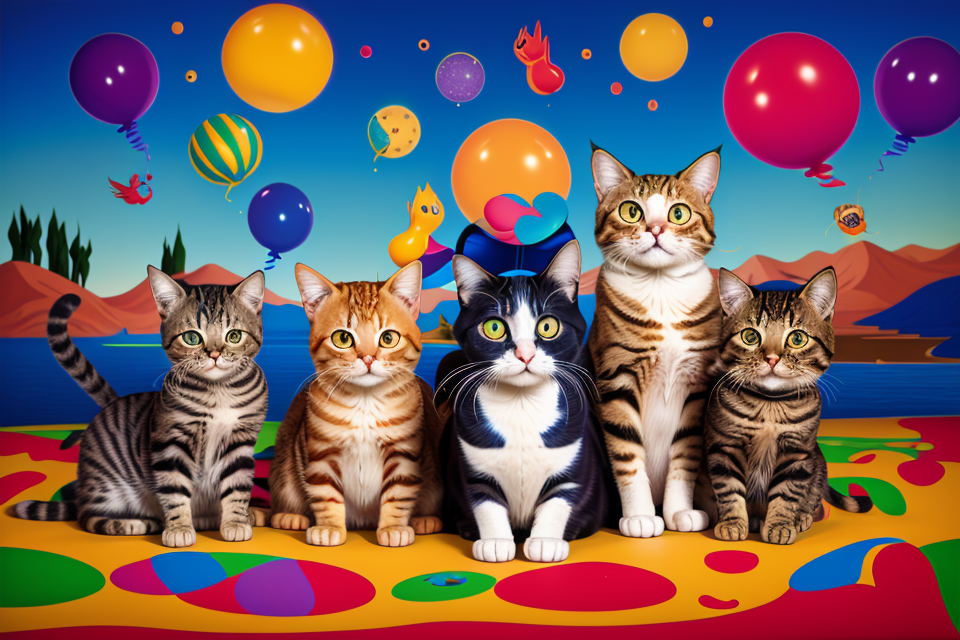
Cats have been a favorite subject of artists for centuries, capturing their unique grace, beauty, and mysterious aura. In art, cats have symbolized various aspects of human life, from the playful and carefree to the sly and enigmatic. From ancient Egyptian art to contemporary pop culture, cats have been portrayed in countless forms, each one offering a glimpse into the human psyche and our complex relationship with these enigmatic creatures. In this article, we will explore the many roles that cats play in artistic representation, and what they reveal about our own desires, fears, and fascinations. So, let’s dive into the world of feline symbolism and discover the secrets that these mesmerizing creatures hold.
Cats have been a popular subject in artistic representation for centuries, appearing in paintings, sculptures, and other forms of art. They are often depicted in a variety of poses and styles, ranging from realistic portrayals to abstract interpretations. Cats have been used as a symbol of grace, beauty, and independence in many works of art, and have also been used to convey a sense of mystery and intrigue. In addition to their aesthetic appeal, cats have also played a role in the development of artistic techniques and styles, such as the use of shading and light in paintings. Overall, cats have had a significant impact on artistic representation and continue to be a popular subject for artists today.
The History of Cats in Art
Ancient Civilizations and Cat Depictions
Cats have been a part of human history for thousands of years, and their presence in art spans across different civilizations and cultures. Ancient civilizations such as the Egyptians, Greeks, and Romans depicted cats in their art, and these depictions offer insight into the relationship between humans and cats during that time.
In ancient Egypt, cats were considered sacred animals and were often depicted in art as part of the household or as symbolic representations of fertility and protection. The goddess Bastet, for example, was often depicted with the head of a cat, and her worship was associated with the protection of the home and family.
Greek and Roman art also featured cats, although they were not held in as high regard as in ancient Egypt. Cats were often depicted in paintings and sculptures as pets or as part of scenes of everyday life.
The relationship between humans and cats in ancient art can provide insight into the cultural significance of cats during that time. The depiction of cats in ancient art can also offer insight into the way humans viewed and interacted with cats during that time.
The Emergence of Cat Art in Europe
Cats have been depicted in art for centuries, with their earliest appearances in ancient Egyptian art. However, it was not until the Renaissance period in Europe that cats began to be depicted in a more realistic and accurate manner.
One of the earliest known examples of cat art in Europe is a fresco painting from the Palace of Knossos in Crete, which dates back to around 1500 BCE. The painting depicts a cat being held by a woman, and it is believed to be one of the earliest known depictions of a domesticated cat in European art.
During the Renaissance period, cats became increasingly popular as pets among the wealthy classes in Europe, and this led to a surge in the depiction of cats in art. Artists such as Leonardo da Vinci and Jan Brueghel the Elder depicted cats in their paintings, often portraying them as playful and mischievous creatures.
In the 17th and 18th centuries, cat art became even more popular in Europe, with many artists creating paintings and sculptures of cats in a variety of poses and settings. These works often emphasized the beauty and grace of the cat’s movements and the softness of their fur.
Overall, the emergence of cat art in Europe can be seen as a reflection of the growing popularity of cats as pets, as well as a reflection of the changing attitudes towards animals in art and society as a whole.
The Symbolism of Cats in Art
Cat as a Symbol of Independence and Freedom
Cats have long been a popular subject in art, with many artists using them to symbolize independence and freedom. This is likely due to the fact that cats are known for their independent and free-spirited nature, often choosing to do things their own way rather than following the rules or expectations of others.
One way that cats are used to symbolize independence and freedom in art is through their depiction as solitary creatures. Many artworks featuring cats show them alone, whether it be lounging in a sunbeam or prowling through the night. This emphasizes their self-sufficiency and ability to thrive on their own terms.
Another way that cats are used to symbolize independence and freedom in art is through their association with the natural world. Cats are often depicted as being in tune with their surroundings and able to adapt to their environment, whether it be the city or the wilderness. This emphasizes their ability to live on their own terms and be self-reliant.
Finally, cats are often used to symbolize independence and freedom in art because of their association with the mysterious and unpredictable. Cats are known for their elusive nature and their ability to keep secrets, which can make them seem like enigmatic and independent creatures. This can make them a powerful symbol of freedom and individuality in art.
Overall, cats have long been used in art as a symbol of independence and freedom. Whether it be through their depiction as solitary creatures, their association with the natural world, or their mysterious and unpredictable nature, cats have come to represent the idea of being self-sufficient and free-spirited.
Cat as a Symbol of Mystery and Magic
Cats have been used as symbols of mystery and magic in art for centuries. This is because they have long been associated with the supernatural and the unknown. In many cultures, cats were believed to have mystical powers and were often used in rituals and ceremonies.
One of the reasons cats were seen as mystical creatures was their ability to see in the dark. This was seen as a sign of their otherworldly powers, and many people believed that they could see things that humans could not. This led to cats being depicted in art as guardians of the unknown, keeping watch over mysterious and magical places.
Cats were also associated with magic and witchcraft, particularly in the Middle Ages. In many European cultures, cats were believed to be the familiar spirits of witches, and were often depicted in art as such. This association with witchcraft and magic further reinforced the idea of cats as mysterious and otherworldly creatures.
In addition to their association with the supernatural, cats were also seen as symbols of independence and freedom. They were often depicted in art as solitary creatures, living in the wild and avoiding human contact. This independence and freedom was seen as a reflection of the cat’s mysterious and enigmatic nature.
Overall, the symbolism of cats as symbols of mystery and magic has been a consistent theme in art throughout history. From their association with the supernatural to their representation as independent and free creatures, cats have played a significant role in artistic representation as symbols of the unknown and the magical.
Cat as a Symbol of Love and Affection
Cats have been depicted in art as symbols of love and affection for centuries. Their gentle and affectionate nature has made them a popular subject for artists, who have used them to convey a range of emotions and themes. In many cultures, cats are seen as symbols of maternal love and nurturing, and are often depicted in paintings and sculptures as caring for their young.
One of the most famous examples of a cat as a symbol of love and affection is the statue of the “Venus de Milo,” which is one of the most famous works of ancient Greek art. The statue depicts a woman with her arms outstretched, holding a cat in her arms. The cat is often interpreted as a symbol of love and affection, and the statue is seen as a representation of the ideal of feminine beauty and motherly love.
Another example of a cat as a symbol of love and affection can be found in the works of the Dutch painter Johannes Vermeer. In his painting “Girl with a Pearl Earring,” Vermeer depicts a young girl holding a cat, which is often interpreted as a symbol of her affection for the girl. The cat is also seen as a symbol of the girl’s innocence and purity, and the painting is seen as a representation of the ideal of feminine beauty and virtue.
In addition to their association with love and affection, cats have also been depicted in art as symbols of mystery and magic. In many cultures, cats were believed to have mystical powers and were often associated with the supernatural. They were also seen as symbols of wisdom and knowledge, and were often depicted in art as guardians of secret knowledge and wisdom.
Overall, cats have played a significant role in artistic representation throughout history, serving as symbols of love and affection, as well as mystery and magic. Their gentle and affectionate nature has made them a popular subject for artists, who have used them to convey a range of emotions and themes.
The Representation of Cats in Different Art Styles
Realistic Cat Portraits
Throughout history, cats have been depicted in various forms of art, with one of the most popular styles being realistic cat portraits. These portraits aim to capture the essence of the feline form, emphasizing their unique features and characteristics. In this section, we will delve into the intricacies of realistic cat portraits and the artists who have mastered this style.
The Golden Age of Cat Portraits
The golden age of cat portraits can be traced back to the 17th and 18th centuries, where artists such as Johannes Vermeer and Rembrandt depicted cats in their works. These artists used oil painting techniques to create lifelike representations of cats, showcasing their grace and elegance. The realistic portrayal of cats during this time period helped to elevate the status of felines from mere household pets to objects of artistic admiration.
Feline Anatomy and Physiology
In order to create an accurate and realistic cat portrait, an artist must have a deep understanding of feline anatomy and physiology. This includes the study of a cat’s skeletal structure, muscles, and fur patterns. By carefully observing these features, artists can create a lifelike representation of the cat, capturing its unique characteristics and personality.
The Importance of Light and Shadow
Light and shadow play a crucial role in creating a realistic cat portrait. By carefully manipulating light and shadow, artists can bring depth and dimension to their works. This technique is particularly important when depicting the fur of a cat, as it allows the artist to create a sense of texture and movement.
Modern Realistic Cat Portraits
In modern times, artists continue to create realistic cat portraits using a variety of mediums. From oil paintings to digital art, artists strive to capture the essence of the feline form, highlighting their unique features and characteristics. In doing so, they contribute to the rich history of cat portraits in art, further solidifying the cat’s place as a beloved subject in the art world.
Stylized and Abstract Cat Imagery
Throughout history, cats have been portrayed in various forms of art, ranging from realistic depictions to highly stylized and abstract representations. The use of stylized and abstract cat imagery in art has become a popular technique for artists to convey their interpretation of the feline form and its unique characteristics.
In this style of representation, artists often focus on the geometric shapes and lines that make up the cat’s form, exaggerating certain features such as the eyes, ears, and tail to create a more abstract representation of the animal. This technique allows artists to explore the cat’s sleek and agile body, as well as its mysterious and elusive nature.
The use of bright colors and bold brushstrokes also plays a significant role in stylized and abstract cat imagery. Artists often use vibrant colors to draw attention to specific features of the cat, such as its eyes or fur, while also creating a sense of movement and energy in the composition.
Furthermore, stylized and abstract cat imagery often conveys a sense of playfulness and whimsy, with cats depicted in imaginative and fantastical scenarios. This style of representation allows artists to push the boundaries of traditional depictions of cats and explore new and exciting ways of portraying these fascinating animals.
Overall, the use of stylized and abstract cat imagery in art serves to highlight the unique and captivating qualities of cats, while also allowing artists to express their own creative vision and interpretation of these fascinating animals.
Surrealist and Dreamlike Cat Art
Surrealist and dreamlike cat art has a unique and captivating quality that has captured the imagination of many artists. This style of art is characterized by its use of symbolism, imagination, and dreamlike imagery. The cats in this type of art are often portrayed in a way that is both dreamlike and surreal, with elements of fantasy and the subconscious woven into the artwork.
One of the most notable characteristics of surrealist and dreamlike cat art is its use of symbolism. Cats have long been associated with mystery, independence, and even a certain degree of enigma. In surrealist art, these qualities are often emphasized, with cats portrayed in ways that reflect their mystical and mysterious nature. For example, a cat may be depicted as floating in mid-air, or surrounded by strange and otherworldly elements.
Another characteristic of surrealist and dreamlike cat art is its use of dreamlike imagery. This type of art often reflects the subconscious mind, with images that are both fantastical and otherworldly. Cats are often portrayed in a way that reflects this dreamlike quality, with depictions that are both surreal and imaginative. For example, a cat may be depicted as having wings, or as being surrounded by clouds and other ethereal elements.
Surrealist and dreamlike cat art is also characterized by its use of vivid colors and bold brushstrokes. This style of art is often associated with the works of famous surrealist artists such as Salvador Dali and Rene Magritte, who used vivid colors and bold brushstrokes to create dreamlike and imaginative artworks. In cat art, this same sense of boldness and imagination is often reflected, with cats portrayed in vivid colors and with bold, expressive brushstrokes.
Overall, surrealist and dreamlike cat art is a unique and captivating style of art that has captured the imagination of many artists. This type of art reflects the mystical and mysterious nature of cats, while also incorporating elements of fantasy and the subconscious. Through its use of symbolism, dreamlike imagery, and bold colors, surrealist and dreamlike cat art continues to inspire and captivate those who view it.
The Impact of Cat Art on Popular Culture
The Rise of Cat-Themed Merchandise
As cat art continued to gain popularity, it also gave rise to a new market for cat-themed merchandise. From t-shirts to mugs, toys, and even home decor, cat-themed products have become a staple in popular culture. The widespread appeal of these items has led to a thriving industry, with cat lovers and collectors eager to add to their collections.
One reason for the success of cat-themed merchandise is the wide range of designs and styles available. Artists have created everything from quirky cartoon cats to lifelike depictions of the animals, allowing consumers to choose from a variety of options that reflect their personal tastes and interests. This diversity has helped to expand the market and attract a broader audience, including those who may not be interested in traditional cat art.
Another factor contributing to the rise of cat-themed merchandise is the convenience and accessibility of online shopping. With the proliferation of e-commerce platforms, it has become easier than ever for consumers to find and purchase cat-themed products from all over the world. This has helped to fuel the growth of the industry and created new opportunities for artists and entrepreneurs to showcase their work and reach a global audience.
In addition to the commercial success of cat-themed merchandise, it has also helped to raise awareness about cat welfare and conservation. Many artists and companies have used their platforms to promote animal rights and responsible pet ownership, using their cat-themed products to educate consumers and inspire action. This has contributed to a greater appreciation for cats and their importance in our lives, both as pets and as symbols of creativity and inspiration.
Overall, the rise of cat-themed merchandise is a testament to the enduring appeal of cats in art and popular culture. It has created new opportunities for artists and entrepreneurs, while also helping to raise awareness about cat welfare and conservation. As the market continues to grow and evolve, it is likely that we will see even more innovative and creative cat-themed products emerge, further solidifying the role of cats in artistic representation.
The Influence of Cat Art on Contemporary Culture
The impact of cat art on contemporary culture is undeniable. Cats have been featured in various forms of art, from paintings to sculptures, and even in literature. These artistic representations of cats have played a significant role in shaping the way society views and interacts with them.
One of the most significant ways in which cat art has influenced contemporary culture is through its impact on the fashion industry. The iconic Chanel No. 5 perfume bottle, designed by Coco Chanel in the 1920s, features a black cat as its symbol. This has become one of the most recognizable and enduring symbols of fashionable elegance in the world.
Another way in which cat art has influenced contemporary culture is through its impact on advertising. Cat-themed advertisements have become increasingly common in recent years, with companies using images of cats to sell everything from food to clothing. This has led to a growing awareness of cats as desirable and fashionable creatures, which has had a significant impact on the way they are perceived by society.
In addition to its impact on fashion and advertising, cat art has also influenced contemporary culture through its impact on literature. Cat characters have been featured in countless works of fiction, from classic novels to modern-day bestsellers. These characters have become beloved by readers around the world, and have helped to shape the way society views cats as intelligent, curious, and even mischievous creatures.
Overall, the influence of cat art on contemporary culture is undeniable. From its impact on fashion and advertising to its influence on literature, cat art has played a significant role in shaping the way society views and interacts with these fascinating creatures.
The Future of Cat Art
The Evolution of Cat Art in the Digital Age
As technology continues to advance, the way in which artists create and present their work is constantly evolving. In the realm of cat art, the digital age has brought about a significant shift in the way cats are represented and perceived.
One of the most notable changes in the evolution of cat art in the digital age is the rise of digital painting and illustration. With the advent of digital tools and software, artists are now able to create highly detailed and realistic depictions of cats with greater ease and precision than ever before. This has led to a surge in the popularity of digital cat art, as well as a growing appreciation for the unique qualities of digital media in the representation of cats.
Another important development in the evolution of cat art in the digital age is the rise of online communities and social media platforms. These platforms have provided a space for artists to share their work and connect with other cat lovers and art enthusiasts from around the world. As a result, cat art has become more accessible and inclusive, with a wider range of artists and styles being represented and celebrated.
Additionally, the digital age has also enabled new forms of collaboration and experimentation in cat art. With the ability to easily share and exchange ideas and techniques, artists are now able to push the boundaries of traditional cat art and create innovative and groundbreaking works that challenge our perceptions of cats and their place in art.
Overall, the evolution of cat art in the digital age has opened up new possibilities for artists and cat lovers alike, and has helped to solidify the important role that cats play in artistic representation.
The Continued Relevance of Cats in Artistic Expression
Despite the passage of time and the emergence of new forms of art, cats continue to hold a prominent place in artistic expression. Their enduring appeal can be attributed to several factors, including their aesthetic qualities, their ability to evoke a range of emotions, and their cultural significance.
One reason why cats remain relevant in artistic representation is their aesthetic qualities. They possess a unique blend of grace, agility, and mystery that has captivated artists for centuries. Their sleek and slender bodies, combined with their piercing eyes and distinctive markings, make them a visual delight. Artists have been drawn to these features, using them to create striking and memorable works of art.
Cats also have the ability to evoke a range of emotions in viewers. They can convey feelings of calmness and tranquility, as well as mischief and playfulness. They can represent both independence and affection, depending on the context in which they are portrayed. This versatility makes them a popular subject for artists, who can use them to explore different themes and ideas.
Furthermore, cats hold cultural significance in many societies around the world. They have been associated with everything from good luck to witchcraft, and their presence in art reflects these varied meanings. They have been depicted in religious iconography, folk art, and contemporary art, demonstrating their enduring cultural relevance.
In conclusion, the continued relevance of cats in artistic expression can be attributed to their aesthetic qualities, their ability to evoke a range of emotions, and their cultural significance. As artistic trends come and go, cats remain a timeless and beloved subject, inspiring artists to create some of their most memorable works.
FAQs
1. What is the significance of cats in art?
Cats have been a popular subject in art for centuries, representing different meanings and symbols across various cultures. In ancient Egypt, cats were worshiped as sacred animals and were often depicted in art as powerful and mystical creatures. In Japanese art, cats were associated with good luck and fortune, while in European art, they were often portrayed as mischievous and playful animals.
2. How have cats been represented in different art styles?
Cats have been depicted in various art styles, including paintings, sculptures, and drawings. In impressionist art, cats were often portrayed as relaxed and content, while in surrealist art, they were often depicted in dreamlike and fantastical scenes. In pop art, cats were often shown as playful and quirky characters, while in minimalist art, they were often portrayed in simple and abstract forms.
3. What is the symbolism behind cats in art?
Cats have been used as symbols of various traits and characteristics in art, such as independence, grace, and mystery. They have also been associated with the feminine and the occult, as well as with nature and the animal kingdom. The symbolism of cats in art can vary depending on the culture and the time period in which the art was created.
4. How have cats been used in contemporary art?
Cats continue to be a popular subject in contemporary art, often being depicted in new and innovative ways. They are used to explore themes such as popular culture, technology, and the human-animal relationship. In street art and graffiti, cats are often portrayed in a playful and mischievous manner, while in digital art, they are often depicted in futuristic and surreal environments.
5. Why are cats such a popular subject in art?
Cats have been a popular subject in art for centuries due to their unique and captivating qualities. They are often seen as mysterious and elusive creatures, as well as being known for their beauty and grace. Additionally, cats have a strong connection to human emotions and are often used in art to explore themes such as love, loneliness, and companionship.

